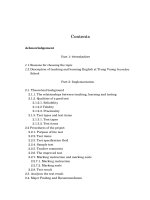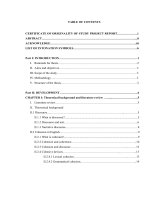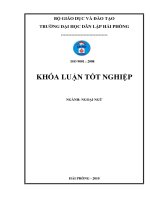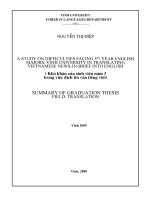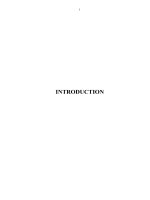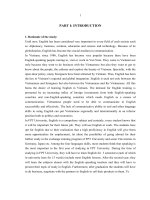A study on effectual enrichment through work life responsible HRM practices in select it & ITES organizations of Hyderabad, India
Bạn đang xem bản rút gọn của tài liệu. Xem và tải ngay bản đầy đủ của tài liệu tại đây (415.45 KB, 9 trang )
International Journal of Management (IJM)
Volume 7, Issue 7, November–December 2016, pp.217–225, Article ID: IJM_07_07_022
Available online at
/>Journal Impact Factor (2016): 8.1920 (Calculated by GISI) www.jifactor.com
ISSN Print: 0976-6502 and ISSN Online: 0976-6510
© IAEME Publication
A STUDY ON EFFECTUAL ENRICHMENT THROUGH
WORK LIFE RESPONSIBLE HRM PRACTICES IN
SELECT IT & ITES ORGANIZATIONS OF
HYDERABAD, INDIA
K. L. Revathi
Assistant Professor, Department of Management, IARE, Hyderabad, India
Sreekanth Yerramilli
Research Scholar, Department of HRM, GITAM, Hyderabad, India
Abdul Afsar Pasha
Assistant Professor, Department of Management, IARE, Hyderabad, India
ABSTRACT
The Study tries to elucidate the Work Life Positivity from an organizational perspective &
several allied practices that are observed influential Employees in professional & personal
imperatives in an enriching way and it also tries to cover the various effectual organizational
outcomes by virtue of such practices. This conceptual study also want to project a macro level
picture of the ongoing need of observing Work Life as part of the same compendium rather than
seeing them as two different entities trying to balance each other and also the current burgeon
necessity of work family responsible organizations’ quest for Individuals’ fundamental positive
antecedents like Harmony, Happiness, Contentment etc from Work Life perspectives for an
integrated overall Employees well being.
Key words: Work Life, Enrichment Practices, Work Family Responsibility, Positive outcomes
Cite this Article: K. L. Revathi, Sreekanth Yerramilli and Abdul Afsar Pasha, A Study on
Effectual Enrichment Through Work Life Responsible HRM Practices in Select IT & ITes
Organizations of Hyderabad, India. International Journal of Management, 7(7), 2016, pp. 217–225.
/>
1. INTRODUCTION
The Globally integrating work environments are commonly perceived decreasing the workload of
employees by virtue of the most advanced Information & Communication Technologies. The connected
networks, Telecommuting facilities of working environments, cloud based network systems are enabled by
new communication technology interfaces such as Mobile computing devices, smart mobile technologies
etc. These provide employees various options for performing their daily tasks & also for effective
communications with co-workers, supervisors, clients any time anywhere making the Work environments
/>
217
K. L. Revathi, Sreekanth Yerramilli and Abdul Afsar Pasha
more virtual than real.In the onset ,the widely believed thought is, these flexibility can give individual
workers the opportunity to better balance all their work and home domains positively , as they can allocate
their time over work and family activities in a way that suits their situation best .So to say that the birth of
the technological age has resulted in drastic changes in employee work patterns, including the possibility
of job or task sharing, flexible working, and empowering women & otherwise able workforce. But this in a
way have increased expectations regarding employee availability that indirectly triggers aspects where
sometimes have also resulted in a trend of rise in non-standard work schedules with any time any place
work engagements obligations also.By these it is noted that employees in a way feel these advancements
wipe the distinctions between the Work & other Personal or Life domains, integrating them together for
both positive & negative effects exchanged to each other domains. This resulted in an acute surge in
organizational concerns over Employees’ positivist Work Life scenarios & outcomes
2. THE WORK LIFE THEORY & RESEARCH
Over the past century there are prolific concepts publicized by many celebrated Scholars of the century on
Work Life Balance & Positivity. Especially over past few decades, the growing need for study in the field
of Work Life aspects resulted in phenomenal contributions in the field of positive Work Life
Developments so there seems a slow & steady metamorphosis .The concept of Work Life Research
particularly covered under concepts like Boundary Theory, Segmentation Theory, compensation theory,
Role Theory, Spill Over Theory, Cross Over Theory etc are proliferated. Now several ongoing Work Life
studies are more focusing on the Positive Psychology fundamentally more on the Positive capital gains and
their translations into enrichment gains in other domains of an individual .Rooted in studies like U.
Bronfenbrenner’s ecological systems theory suggests that the work-family experience is a joint function of
process, person, context and time characteristics. And expansion-enhancement hypothesis from Work Life
Enrichment research results that Positive psychological capital predominantly contributes a huge resource
gain in one domain & it transcends accordingly in other domain for enrichment & vice versa.
3. POSITIVE ENRICHING PRACTICES OF WORK LIFE RESPONSIBLE
ORGANIZATIONS
Global IT organizations ,owing to several observations of enriching gains & transcending trends in work
places have geared up working on Family responsible work cultures & practices particularly more with
thriving countries like India being a Family inclined cultural system that would help employees harmonize
both Work & personal domains evenly . As the broader research on Work Life balance evolved it
identified Work & Other intersecting domains of Individuals not just as some entities trying to balance
each other , rather on the contrary it is the composition of same super-set called “Life” that comprise
several domains like Work, Family, Friends, personal interests etc (Tracey. Warren .2004 )trying to
harmonize for individualistic happiness .These practices & policies around the practices revolve around the
organization in terms of flexibility and conciliation practice. These would also measure the impact of
leadership on individual and company outcomes.
4. KEY OBJECTIVES OF STUDY
•
Studying the perception of employees regarding positive enhancing practices & leadership, culture that
contribute to the reconciliation of work, family and personal life.
•
Explore Positive Work outcomes of the company through the Work Life responsible facilitation
practices.
•
Identify key drivers capable of producing positive changes in the Work Family culture of the employees
•
Identify the degree of leadership development and corporate culture regarding Family Corporate
Responsibility
/>
218
A Study on Effectual Enrichment Through Work Life Responsible HRM Practices in Select IT & ITes Organizations
of Hyderabad, India
5. HYPOTHESIS
1. H0- A-Null Hypothesis: Organizational practices Creativity /Innovation/Task Autonomy , Fun,
Health, Knowledge & Time facilitation are Not efficient in contributing Work Positive outcomes
like Stress Reduction, Work Motivation, Productivity Improvement ,Attrition Control & job
enhancement
2. H1- A Alternative Hypothesis: Organizational practices Innovation, Fun, Health, Knowledge &
Time facilitation are efficient in contributing Work Positive outcomes like Stress Reduction, Work
Motivation, Productivity Improvement, and Attrition Control & job enhancement
3. H0-B-Null Hypothesis: The model is not efficient in linking Stress Management, Productivity
Improvement, Attrition Control, and Motivation to Perform to Work family/ life enrichment
4. H1-B Alternative Hypothesis: The model is efficient in linking Stress Management, Productivity
Improvement, Attrition Control, and Motivation to Perform to Work family /life enrichment
6. RESEARCH METHODOLOGY
A stepwise linear regression method is employed using the dependent variables and normalized scores of
ranking to antecedential factors from the Independent variables loaded for analysis. Also here , in order to
harness more quality out of responses & minimize casual inferences , the 5 key drivers of the positive
effect are captured in 2 layers wise ranking & rating to capture generic life-attribution priorities on these
enriching elements & secondly as situational work family drivers with 5 point likert scale questions .
7. DATA ANALYSIS
7.1. Data Setting
•
•
•
•
Every employee is asked to give a rank to following enrichment factors
1. Creativity /Innovation /Lateral Thinking,
2. Fun, Cultural, sports, hobbies, Activities clubs, friends,
3. Job Relevant Knowledge, Skills, Training, Process education,
4. Health & Wellness facilities
5. Work from Home/ Time flexibility/Work driven not time based on life needs
These ranks are normalized based on the responses provided by the employees, then the employees
rated them also on 5 point likert scale on how they perceive these practices contributes to the work
system particular to following positive outcomes.
1. Reduce Work Life stress
2. Attrition Control & build loyalty
3. Motivation to higher performance
4. Improve organizational productivity
5. Overall Work life enrichment
These responses are also normalized
The average of the above normalized responses is computed and is taken
7.1.1. Sample Collection
Sample was collected using cascading snowball model across different IT & ITes organizations of
Hyderabad, India as cluster sampling method with both self administered & personal interview questioner
given to respondents.
7.1.2. Data Analysis Software
The Research used SPSS (2.0) Software to analyze the data collected.
/>
219
K. L. Revathi, Sreekanth Yerramilli and Abdul Afsar Pasha
7.2. Results & Tables of Outcomes
7.2.1. Pairwise Correlations - Test 1
Dependent Variable: Managing_Stress_at_Family_and_Work & Predictors: (Constant), Zscore: Health &
Wellness facilities
7.2.2. Pairwise Correlations: Test 2
Dependent Variable: Lesser Attrition & Job Enclenchement Predictors: (Constant), Zscore: Fun, Cultural ,
sports, hobbies , Activities clubs, friends
7.2.3. Pair wise Correlations- Test 3
Dependent Variable: Motivation_To_Perform Predictors: (Constant), Zscore: Fun, Cultural , sports,
hobbies , Activities clubs, friends
/>IJM/index.asp
220
A Study on Effectual Enrichment Through
rough Work Life Responsible HRM Practices in Select IT & ITes Organizations
of Hyderabad, India
7.2.4. Pairwise Correlations- Test 4
Dependent Variable: Productivity Improvement Predictors: (Constant), Z score: Health & Wellness
facilities;
7.3. Work Out Comes & their Work to Family Enrichment Effect
A model to check which of the outcomes at work (Stress Management, Productivity Improvement,
Attrition Control, and Motivation to Perform) contribute significantly to the Work family /life enrichment.
7.3.1. Data Setting
Based on the normalization of ratings given by the employees on Practices like Creativity /Innovation
/Lateral Thinking, Fun, Cultural, sports, hobbies, Activities clubs, friends, Job Relevant Knowledge, Skills,
Training, Process education, Health & Wellness facilities, Work From Home/ Time flexibility/Work
Driven not time driven Work systems contributing to Stress Management, Productivity Improvement,
Attrition Control, and Motivation to Perform, scores are computed for each of the outcomes
• Similarly
rly scores are computed for Overall work life enrichment as well based on the above procedure
7.3.2. Method Used
A Stepwise linear regression using the Worklife_Enrichment as the dependent variable and scores
corresponding to Stress Management, Productivity Improvement, Attrition Control, and Motivation to
Perform as Independent variables is employed.
7.4. Results
7.4.1. Pairwise Correlations
Work Micro system Outcomes
Worklife_Enrichment
Worklife_Enrichment
1.000
Managing_Stress_at_Family_and_Work
.725
Lesser_Attrition_Probability
.683
Motivation_To_Perform
.777
Productivity_Improvement
.877
/>IJM/index.asp
221
K. L. Revathi, Sreekanth Yerramilli and Abdul Afsar Pasha
Managing_Stre
Worklife_Enric ss_at_Family_a Lesser_Attritio Motivation_To_ Productivity_I
hment
nd_Work
n_Probability
Perform
mprovement
Worklife_Enrichment
Managing_Stress_at_Family
_and_Work
Lesser_Attrition_Probability
Motivation_To_Perform
Productivity_Improvement
1.000
.725
.725
1.000
.683
.774
.777
.780
.877
.816
.683
.777
.877
.774
.780
.816
1.000
.746
.753
.746
1.000
.839
.753
.839
1.000
7.4.2. Principal Component Analysis
/>
222
A Study on Effectual Enrichment Through Work Life Responsible HRM Practices in Select IT & ITes Organizations
of Hyderabad, India
8. FINDINGS & SUGGESTIONS
•
By the above independent correlation tests on different Organizatiational outcomes of select enrichment
practices, it is evident that work and family domains are positively correlated predominantly with Health
and wellness facilities & providing Fun, Cultural, sports Activities and camaraderie .Where, also
Motivation to perform is moderately negatively correlated with Fun, Cultural, sports, hobbies, Activities
clubs, and friends as it widely perceived diluting the focus of work . Though there was only a moderate
correlation to other practices like Creativity /Innovation /Task Autonomy, Time Flexibility &
Knowledge facilitations, these could be subjective areas and could be dependent on the domains of
sample observed.
•
And further observations into understanding the gross effectual Work to Family enrichment spill over,
there are 4 component outcomes considered and each outcome in turn is based on the responses
associated with practices themed Creativity /Innovation /Lateral Thinking, Fun, Cultural , sports,
hobbies , Activities clubs, friends, Job Relevant Knowledge ,Skills, Training, Process education, Health
& Wellness facilities, Work From Home/ Time flexibility/Work Driven not time driven Work systems.
Here it is clearly evident that Work life enrichment is highly positively correlated with each of the
organizational outcomes (Stress Management, Productivity Improvement, Attrition Control, and
Motivation to Perform). And it also revealed that there is a lot of multi-co linearity as is evident from
higher correlations among the independent variables as well
•
The above component matrix suggests that component 1 is heavily influenced by all the four outcomes
as can be seen by their correlation with component 1.indicating the amount of weight age that needs to
be given to each of the 4 outcomes in the integrated component. Here also we see that the weights are
more or less equal across all outcomes, indicating that all of them are equally influencing the Work life
enrichment
/>
223
K. L. Revathi, Sreekanth Yerramilli and Abdul Afsar Pasha
•
Now when linear regression is performed with work life enrichment score as the dependent variable and
the component obtained by integrating the outcomes variables as the independent variable. R-Squared
for the model is 70% indicating that these 4 outcomes together are explaining 70% of the variance in
work life enrichment and the rest 30% of it is supposedly taken care by other factors considered out of
the folds of the study could be as discussed earlier factors like Monitory gains, Career gains, Brand
Association etc .
•
However, we could summarise these gross results that 70% of Work life enrichment is contributed by
following the studied practices. A positive value of the coefficient (0.589) indicates that an increase in
any of the 4 outcomes through these practices will increase the work life enrichment of the individual
towards positivity.
9. CONCLUSION
The rapid dynamics of Work and Personal Lives of present day Employees is always at cross roads of
survival imperatives & overall happiness , as it is beyond dispute that irrespective of age ,era &
advancements Human thought & its quest for happiness is beyond any realm of objective so called social
security goals & monitory gains and is more inclined towards inner subjectivity .And here , global work
systems are transcending towards being total individual centric concepts organizations these days are
transcending towards focusing on such holistic practices to make fit all its employee individual needs
dynamically. During such quest ,this conducted study clearly could summarize that managing stress,
improving productivity ,enclenchement, proactive motivations at work and family are positively correlated
with providing proper autonomy, fun, flexibility, knowledge & Health and wellness facilitations where it
could ease at personal domains & there by result in creating surplus positive psychological capital for
employees at personal & work domains also . Overall it is evident from the study that ,the themed
organizational enrichment -practices are widely opined succefully facilitating positive work to life in
employees through work systems positive outcomes like (Stress Management, Productivity Improvement,
Attrition Control, and Motivation to Perform)and accordingly organizations too strive with more such
employee friendly practices discussed above for a positive increase in the outcomes that would increase the
holistic work life enrichment of the individuals.
REFERENCE
[1]
[2]
[3]
[4]
[5]
[6]
[7]
[8]
[9]
[10]
[11]
Amundson, N.E. (2001). Three-dimensional living. Journal of Employment Counseling, 38, 114-128.
Bailyn, L., Drago, R., & Kochan, T.A. (2001). Integrating work and family life: A holistic approach . A
Report of the Sloan Work–Family Policy Network. MIT Sloan School of Management, Boston M.A.
Bronfenbrenner, U. (1989). Ecological systems theory. Annals of Child Development, 6, 187-249.
Carlson, D. S., Kacmar, K. M., Wayne, J. H., & Grzywacz, J. G. (2006). Measuring the positive side of
the work-family interface: Development and validation of a work-family enrichment scale. Journal of
Vocational Behavior, 68(1), 131-164.
Clark, S. C. (2000). Work/family border theory: A new theory of work/family balance. Human
Relations, 53, 747-770.
Crosby, F. (1984). Job satisfaction and domestic life. In M. D. Lee & R. N. Kanungo (Eds.),
Management of work and personal life (pp. 41-60). New York, NY: Praeger.
Fisher, G.G. (2001). Work/Personal Life Balance: A Construct Development Study (Doctoral
Dissertation, Bowling Green State University, USA). Retrieved February 7, 2008, from ProQuest
Dissertations & Theses database. (UMI No. 3038411)
Florida, R. (2002). The rise of the creative class. New York: Basic Books.
Freud.S, the Mind of the Moralist - Page 424
Frone, M.R., Russell, M., & Cooper, M.L. (1992b). Antecedents and outcomes of work-family conflict:
Testing a model of the work-family interface. Journal of Applied Psychology, 77(1), 65-78.
Greenhaus, J. H., & Parasuraman, S. (1986). A work-non work interactive perspective of stress and its
consequences. Journal of Organizational Behavior Management, 8, 34-60.
/>
224
A Study on Effectual Enrichment Through Work Life Responsible HRM Practices in Select IT & ITes Organizations
of Hyderabad, India
[12]
[13]
[14]
[15]
[16]
[17]
[18]
[19]
[20]
[21]
[22]
[23]
[24]
[25]
[26]
[27]
[28]
Greenhaus, J. H., & Parasuraman, S. (1999). Research on work, family, and gender: Current status and
future directions. In G. N. Powell (Ed.), Handbook of gender and work (pp. 391–412). Thousand Oaks,
CA, US: Sage.
Grzywacz, J. G., & Marks, N. F. (2000). Reconceptualizing the work-family interface: An ecological
perspective on the correlates of positive and negative spill over between work and family. Journal of
Occupational Health Psychology, 5(1), 111-126.
Inglehart, R., Foa, R., Peterson, C., & Welzel, C. (2008). Development, freedom, and rising happiness.
Perspective on Psychological Science, 3, 264–285.
Kahn, R.L., Wolfe, D.M., Quinn, R.P., Snoek, J.D., & Rosenthal, R.A. (1964). Organizational Stress:
Studies in Role Conflict and Ambiguity. New York: Wiley.
Lockwood, N.R. (2003). Work/Life Balance: Challenges and Solutions, Society for Human Resource
Management: Research Quarterly, 2, 1-10.
Luft, J.; Ingham, H. (1955). "The Johari window, a graphic model of interpersonal awareness".
Proceedings of the western training laboratory in group development (Los Angeles: University of
California, Los Angeles)
Parasuraman, S., Greenhaus, J. H., & Granrose, C. S. (1992). Role stressors, social support, and wellbeing among two-career couples. Journal of Organizational Behavior, 13, 339-356.
Poelmans, Steven; Greenhaus, Jeff; Las Heras, Mireia (Eds.) "Expanding the Boundaries of WorkFamily Research: A Vision for the Future", Houndmills, Basingstoke, Hampshire ; England: Palgrave
Macmillan, 2013.
N. Kamakshi Priya and Dr. M. Kalyana Sundaram , A Study on Relationship between HRM Practices,
Employee Wellbeing and Performance in The Selected Private Hospitals in Tiruchirappalli .
International Journal of Management (IJM) , 7 ( 3 ), 201 6 , pp. 69 – 84
Stum, D. L. (2001). Maslow revisited: Building the employee commitment pyramid. Strategy &
Leadership, 29(4), 4-9.
Taylor, R. (2002). The future of work-life balance. ESRC Future of Work Programme Seminar Series.
Retrieved March 30, 2007, from
/>Trends in Global Employee Engagement ( 2015 );AON-Hewitt Survey ,from
/>R. Anbu Ranjith Kumar and Dr. S. Balasubramanian, The Impact of HRM Practices on Employee
Turnover among IT/ITES Organizations. International Journal of Management (IJM), 7(6), 2016, pp.
203–210.
Warren, T. (2004). Working part-time: Achieving a successful work-life balance? The British Journal of
Sociology, 55, 99-122.
Wayne, J. H., Grzywacz, J. G., Carlson, D. S., & Kacmar, K. M. (2007). Work–family facilitation: A
theoretical explanation and model of primary antecedents and consequences. Human Resource
Management Review, 17, 63-76.
Wayne, J. H., Randel, A. E., & Stevens, J. (2006). The role of identity and work–family support in
work–family enrichment and its work-related consequences. Journal of Vocational Behavior, 69, 445461.
Xu, L. (2009). View on Work-family linkage and work-family conflict model. International Journal of
Business and Management, 4 (12), 229-233.
/>
225

